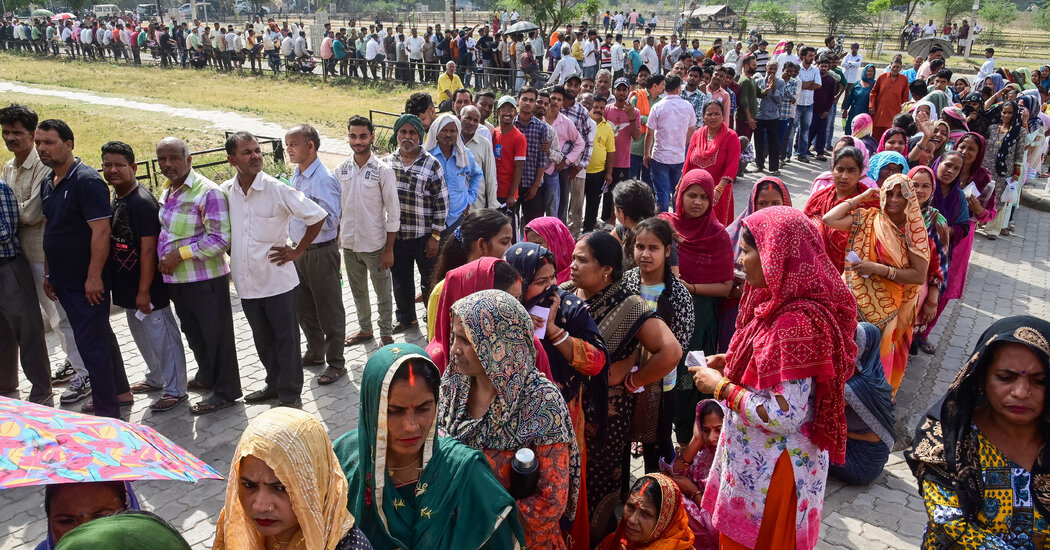
Voting in India’s general election, a six-week-long referendum on Prime Minister Narendra Modi’s decade in power, came to a close on Saturday as much of the country’s populous north was gripped by a deadly heat wave.
Results will be tallied and announced on Tuesday.
Mr. Modi, his power deeply entrenched, is seen as likely to win a third consecutive term as prime minister, which would make him only the second leader in India’s nearly 75 years as a republic to achieve that feat. Exit polls released after the last round of voting suggested a comfortable return for his Hindu-nationalist Bharatiya Janata Party, or B.J.P.
A newly united opposition has put up a fight, rallying against Mr. Modi’s divisive politics and management of India’s deeply unequal economic growth. But the exit polls indicated it was struggling to significantly cut into the sizable majority in the 543-seat Parliament held by Mr. Modi’s party.
In a message of thanks after the voting closed, Mr. Modi expressed confidence that “the people of India have voted in record numbers to re-elect” his government. But Mallikarjun Kharge, the president of the largest opposition party, the Indian National Congress, played down the exit polls as “government surveys” and said the official results will show that his alliance was ahead.
The election, held in phases over a month and a half, is the largest democratic exercise in the world, with more than 950 million eligible voters. The last stretch of the campaigning drew large rallies even as northern India baked under an intense heat wave, with temperatures frequently exceeding 110 degrees Fahrenheit, or more than 43 degrees Celsius.
At least 19 poll workers have died from heat strokes or other health complications resulting from the heat in recent days.
Elections in a parliamentary system like India’s are usually fought seat by seat, with a candidate’s fate determined by local economic and social factors. But the B.J.P. made its parliamentary campaign into a presidential-style referendum, putting the focus almost entirely on Mr. Modi and his leadership. The party hoped that Mr. Modi’s deep popularity would help it overcome a growing anti-incumbent sentiment 10 years into the B.J.P.’s rule.
Mr. Modi held about 200 rallies across the country over more than two months of campaigning, hoping to lift up struggling candidates in his party. He also went on a media blitz, giving about 80 interviews to television stations and newspapers, almost all of them friendly to him.
As the campaigning ended and a mandatory two-day election pause was set to begin, Mr. Modi retreated south to the memorial of one of India’s most celebrated monks for two days of meditation. The country’s media followed. The stream of videos and photos put out by his office, shot from multiple angles in a place where photography is usually not allowed, led the nightly news and television debates.
Mr. Modi’s opponents cried foul, saying that the exercise amounted to prohibited campaigning — and that it exemplified the uneven playing field he has created.
“The weather is good. The prime minister is sitting in meditation there and he has mellowed the sun goddess,” Ravi Kishan, an actor and B.J.P. candidate, told local media outlets. “This is historic — amidst intense heat, the wind started blowing today.”
The opposition, hamstrung by arrests and other punitive actions as part of a crackdown, still mustered its most united front in years. Opposition leaders painted Mr. Modi as a friend to billionaires who has struggled to create jobs for the country’s large youth population. They called his party elitist, accusing it of not lifting up those in the middle and lower ends of India’s caste system.
The opposition has stoked fears that if the B.J.P. remained in power, it might change the country’s Constitution to do away with affirmative action for middle and lower castes, a system put in place many decades ago to address centuries of oppression in India’s rigidly hierarchical society.
Mr. Modi has vehemently rejected the charges as unfounded; the party under him has increased its outreach to lower castes. To try to keep his Hindu support base united, he turned to anti-Muslim rhetoric, leveling attacks that were unusually direct for him in recent years.
The opposition has also tried to win over voters by promising a long list of welfare offerings, including the waiving of farmers’ loans, cash transfers for women and paid apprenticeships for the young. Mr. Modi, on the other hand, has stuck to an image of fiscal prudence, only highlighting his existing offerings. That, his party members say, was because he was confident of winning a third term, and he did not want to over-promise.
But even though the opposition seemed to gain some traction, it faces an uphill task in unseating Mr. Modi’s government. He has built a huge electoral advantage with a robust and well-funded political machinery. In the last election, Mr. Modi’s party won 303 seats, nearly six times as many as its closest national competitor, the Indian National Congress party.
Pragati K.B. contributed reporting from Kanyakumari, India.
Discover more from reviewer4you.com
Subscribe to get the latest posts to your email.


